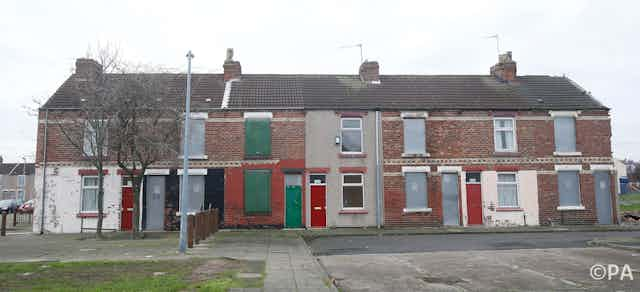We urgently need to rethink the way we receive asylum seekers in the UK. Earlier in the year, it emerged that asylum seekers in the Middlesborough area were suffering from racist abuse, apparently as a result of living in easily identifiable homes with red front doors. Now, the Home Affairs Committee has described an “impending shortage” of homes for asylum seekers. With 20,000 asylum seekers set to arrive in the UK for resettlement before 2020, this is an issue that needs a resolution – and soon.
Since 2012, 8,000 asylum seekers have been housed in 200 of the UK’s 433 local authorities. This means some areas – Glasgow, for instance – have taken in more than 3,000, while other localities have taken none at all. But this is not just a matter of numbers. Uneven dispersal has escalated social tension between locals and asylum seekers, which – in the most serious cases – has led to fatal attacks.
The dispersal scheme
Since 2000, the Home Office has used a “dispersal scheme” to accommodate asylum seekers. Housing is negotiated through networks involving private security firms and local authorities, and asylum seekers who apply for support have to accept whatever accommodation they are offered. To reduce pressure on London and the south-east of England, locations are limited to one of the “dispersal areas”, where fewer people want to live and there is less demand for housing.
Critics have pointed out several problems with this approach. For one thing, these dispersal sites are often in deprived and “difficult-to-let” areas, where accommodation may be sub-standard. What’s more, the “no choice” dispersal policy reinforces the negative perception of refugees, asylum seekers and immigrants as a “burden” that must be spread. It is also controversial because – like detention and deportation – the policy has been viewed as a means to deter people with legitimate claims to asylum.

Despite these issues, the government seems set to continue with the current approach. Both the Home office and the Home Affairs Committee have agreed that more local authorities should be brought into the dispersal scheme, to address the housing shortage. To do so, the Home Office will also need to ensure that local authorities are adequately funded to accommodate and support asylum seekers. This might be challenging if the approach continues to be driven by the availability of more “difficult-to-let” properties.
If the scheme is extended, local authorities in areas such as Maidenhead, Lincoln, Warwick, Cambridge, Cornwall, Midlothian and York – which appear not to have accommodated any asylum seekers at all – will need to heed previous lessons to minimise the risk of social discord.
A warm welcome
One of the most important of the lessons to have emerged from research is that local communities need to be prepared for the arrival of asylum seekers. They also need time to adjust to the presence of newcomers. The arrival of large numbers of people within a short period of time can cause resentment. Many believe that asylum seekers come to the UK to claim benefits – often on fraudulent grounds – rather than to escape from war and political persecution in their homeland. Local authorities must work with communities to dispel the widespread myths around why people claim asylum.
A major consideration is where new arrivals are housed. Previous research has revealed that allocating housing to asylum seekers in economically deprived neighbourhoods may cause local residents concern about increased competition for jobs and services. If at all possible, local authorities should avoid housing asylum seekers in these areas. If this is not possible, they should assure local communities of investment to prevent them feeling disadvantaged.
Another question is whether individuals from the same country of origin or nationality should be clustered together or distributed across the local area. New arrivals face many practical challenges, from managing on a limited budget to acquiring fluency in English. Some may be coping with the loss of family, friends, and homes, and wary of seeking help for fear of racial harassment. Ensuring people are housed close to others who have undergone similar experiences can provide valuable informal support through shared language, values and customs.
However, allocating housing to high numbers of people from the same group within a local area increases their visibility, and reduces opportunities to get to know local people. And some asylum seekers may be keen to begin integrating into local communities, and prefer not to be placed with others from their country of origin. So, it is important to be sensitive to both the local context and to the needs of individuals seeking asylum, and to ensure access to continued formal support.
Finally, local authorities considering taking in asylum seekers should pro-actively work with community groups. A number of faith-based and community organisations, working at local and national levels, have expressed a willingness to welcome asylum seekers and refugees. Examples include the No Accommodation Network, the Quakers Asylum and Refugee Network, Citizens UK and Housing Justice. These groups offer advice, create opportunities to form friendships, hold community events and, in some cases, can even arrange for asylum seekers to be billeted in the homes of local residents.
It is crucial to address the housing shortage. But if local authorities – especially those working in more affluent areas of the UK – can find ways to cooperate with community organisations when accommodating asylum seekers, it will create a friendlier, more welcoming environment for new arrivals. Only then will asylum seekers really be able to begin to feel at home.

